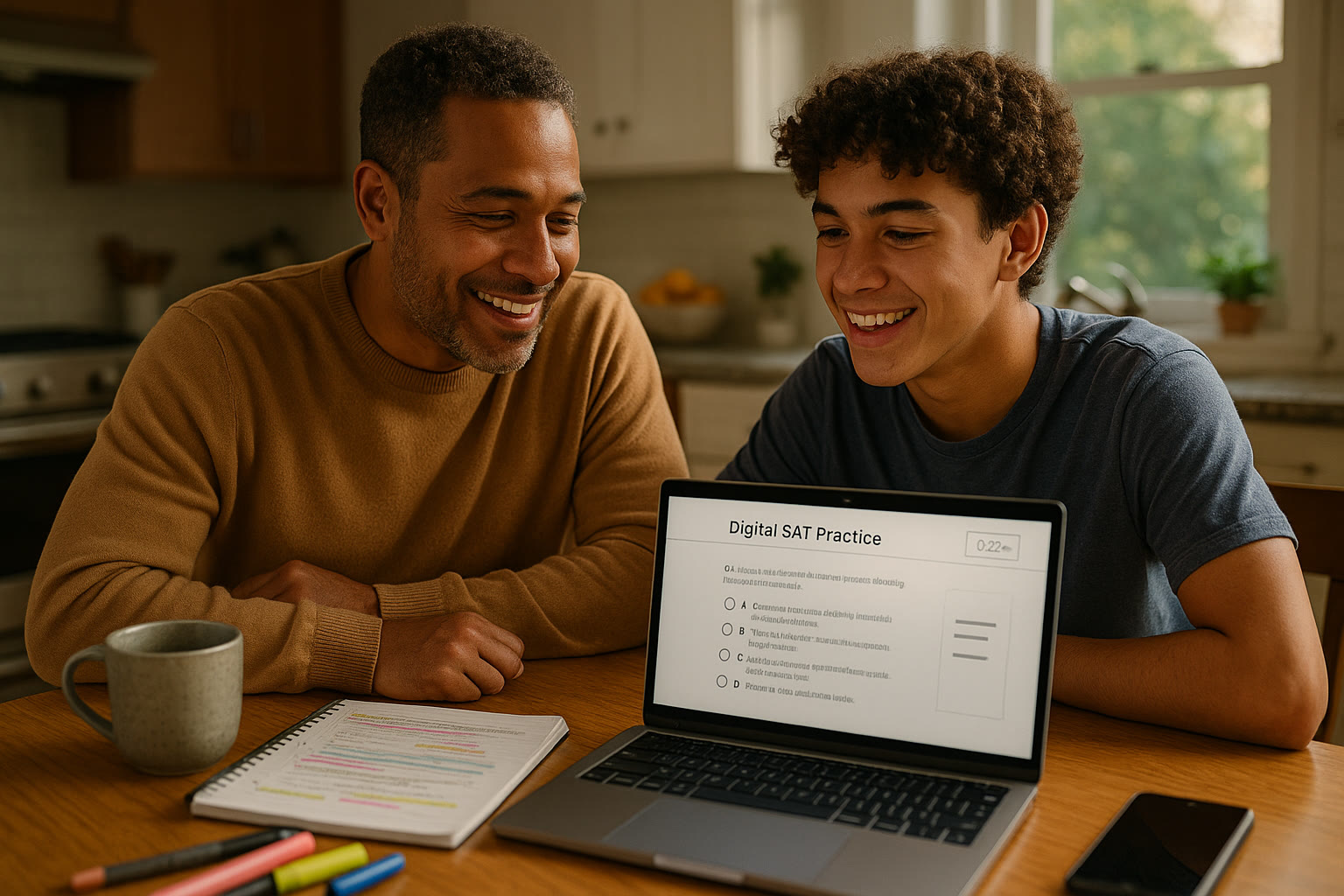Why this balance matters: Helping, not hijacking, the SAT experience
When the words “college entrance exam” enter a household, emotions often rise—pride, anxiety, hope, and the urge to fix every problem for a child you love. The Digital SAT adds a new layer: different format, different preparation rhythms, and new digital test-day logistics. All of that can tempt a parent to step in with good intentions—scheduling extra practice, micromanaging study sessions, or corralling every resource imaginable. But the most helpful path is usually the one that supports independence while keeping the student motivated and confident.
This post is written for parents and students together: clear, practical ways you can be deeply supportive without taking over. We’ll talk about structure, communication, study resources (including when personalized tutoring like Sparkl fits naturally into the plan), test‑day logistics, and emotional coaching. Real examples, an easy-to-follow sample plan, and a comparison table will help you turn goodwill into action that helps your student grow—not just get a higher test score, but become a stronger, more resilient learner.

Start with a shared game plan: conversation before action
Before you buy study guides, sign up for weekend classes, or book a tutor, have a conversation. A short, honest chat sets expectations, builds trust, and clarifies who does what. Here’s a simple structure you can use:
- Ask and listen: Where does the student feel confident? What worries them? How do they prefer to study (short bursts vs. long sessions)?
- Set goals together: Are you targeting a particular score for scholarship or admission? Or is this a practice round to build test‑taking stamina?
- Decide boundaries: When will you check in? How will progress be measured? What’s off-limits (e.g., shaming, constant re-takes of practice tests)?
- Pick a plan and test date range: Agree on a timeline that respects schoolwork, extracurriculars, and mental health.
When the plan is collaborative, the student owns it. That ownership is the foundation for motivation—kids are more likely to follow through on something they helped create.
Make routines that support independence (not control)
Routines reduce friction and decision fatigue for everyone. The goal is to create predictable blocks in which the student does their work autonomously. Parents can support by designing a framework, then stepping back.
Sample weekly routine
- 2 short practice blocks (30–50 minutes) during the week focused on skills (one math, one reading/writing).
- 1 longer session (90–120 minutes) on the weekend for a full-section practice or a timed digital test segment.
- 1 quick weekly check-in with a parent (10–15 minutes) to review progress and feelings—no problem-solving unless asked.
- Monthly reflection and adjustment—what’s working, what’s not.
Parents can help by arranging quiet time, limiting interruptions during practice blocks, and ensuring a comfortable workspace. Resist the temptation to sit behind the student and watch; physical proximity can feel supportive in small doses but often becomes pressure in practice.
Choose resources wisely: quality over quantity
There is no shortage of SAT materials—books, apps, classes, and tutors. Too many options create confusion. Help your student choose a few high-quality resources and stick with them. For the Digital SAT era, look for resources that reflect the test’s format: adaptive sections, shorter overall length, and digital navigation.
What to prioritize
- Official practice tests that simulate the Digital SAT experience—practice on the same platform or interface when possible.
- Practice that focuses on skills and strategy rather than rote question-counting.
- Timed practice to build digital stamina and navigation comfort.
- Personalized support if progress stalls—one-on-one tutoring can quickly address weak points.
When tutoring is a match, it should feel like a collaboration: targeted help, clear homework, and measurable goals. Sparkl’s personalized tutoring—offering one‑on‑one guidance, tailored study plans, expert tutors, and AI-driven insights—fits naturally here when a student needs focused attention on specific weaknesses without parents becoming the on-the-ground coaches.

How to support studying without doing it for them
Support has five clear roles: organizer, motivator, resource manager, stress manager, and advocate. None of these require you to answer every practice question.
Practical ways to fill those roles
- Organizer: Help set up a study calendar but let the student schedule the specific blocks.
- Motivator: Celebrate small wins—completed practice sets, score improvements, or a tough concept mastered.
- Resource manager: Purchase materials, schedule practice tests, or coordinate a tutor—then step back and let the student engage.
- Stress manager: Provide healthy food on test days, encourage good sleep, and model calm behavior around test results.
- Advocate: Communicate with the school or testing center if accommodations or schedule questions arise, but keep the student informed and involved in those conversations.
When to consider one‑on‑one tutoring (and how to make it work)
Not every student needs tutoring. But one-on-one tutoring is a powerful option when:
- Practice scores plateau despite effort.
- There are clear gaps in content knowledge (e.g., algebra foundations) that free resources aren’t fixing.
- Test anxiety or timing issues hurt performance more than content gaps.
If you decide to pursue tutoring, keep these rules in mind:
- Let the student choose or at least meet the tutor first. The relationship matters.
- Set clear, time-limited goals: e.g., “Improve math section percentile by X points in 10 sessions.”
- Encourage independence: tutors should give strategies and homework to be done alone, not spoon-feed answers during sessions.
Sparkl’s personalized tutoring can be helpful because it combines targeted human tutoring with data-driven insights—so parents fund structured help and students get customized lessons without parents micromanaging daily practice.
Modeling emotional resilience: the test is one part of the story
Your tone around the SAT will shape how your child experiences it. Model curiosity and resilience rather than anxiety and blame. Here are phrases that build resilience:
- “Let’s see what this practice test taught you—what surprised you?”
- “That score shows progress. What’s one thing you’d like to focus on next week?”
- “College admissions look at many things. We’ll use the SAT as one tool, not the whole map.”
Avoid comparisons and conditional praise. Instead of “You must score X so we can…,” try “What do you need from me to feel prepared for this test?” Keep conversations short and practical right after a test; debrief later when emotions are calmer.
Test‑day logistics for the Digital SAT: help them be calm and confident
The Digital SAT test day feels different from paper days. Students take the test on approved devices using the Bluebook app (or similar test-center-provided setup). Parents can help by managing logistics ahead of time so the student can focus on the test itself.
Pre‑test checklist
- Confirm test date, time, and test center rules; know arrival windows and ID requirements.
- If testing on a school device or test center machine, verify the student has practiced on a similar digital interface.
- Plan simple, familiar breakfast and a stress-free morning routine. Avoid last‑minute cramming.
- Pack essentials: acceptable ID, water, backup mask (if needed), headphones only if allowed by the center, and any permitted snacks for breaks.
- Practice test-day timing with one or two full-length practice sessions so the student knows how they feel at half- and full-length points.
Let the student lead the test‑day departures. Your calm, businesslike presence will do more good than repeated reminders or urgent coaching in the parking lot.
Measuring progress: what to track and when to intervene
Track progress without obsessing. Focus on a few meaningful metrics: practice-test score trends, time management on sections, and confidence on specific question types. Create a one-page tracker that the student updates weekly.
| Metric | What it shows | When to adjust strategy |
|---|---|---|
| Practice test total score and section percentiles | Overall readiness and relative strengths | Plateauing after 3–4 tests or inconsistent scores |
| Timing per section | Comfort with digital pacing and navigation | Consistently leaving questions blank or rushing on final passages |
| Mistake patterns by question type | Content gaps vs. careless errors | Same errors repeat across multiple practice sessions |
| Student confidence/self-report | Emotional readiness and burnout signs | Rising anxiety or disengagement |
How to give feedback that actually helps
After practice tests or tutoring sessions, feedback should be short, specific, and actionable. Try this micro-script:
- Observation: “You improved on Passage 2—nice work.”
- Impact: “That means your reading pace is stabilizing, which helps the last passage.”
- Next step: “Next week, try timed practice on two short reading passages and review only the mistakes.”
Make feedback a two-way street: ask the student what they think and what they planned to do next. This keeps responsibility with the student while still providing guidance.
Common pitfalls parents fall into—and what to do instead
- Micromanaging: Instead of scheduling every study minute, offer to help design the calendar and let the student fill it in.
- Over-rewarding: Big celebrations for every small score jump can create pressure. Keep rewards proportional and tied to effort, not just results.
- Comparing: Resist comparing progress to other students. Use the student’s own baseline and goals.
- Fixing anxiety by solving: If a student is anxious, ask how they want to be helped—sometimes they want empathy, not a strategy session.
Real-world example: Samantha and her path to calm confidence
Samantha, a high school junior, felt overwhelmed after a diagnostic Digital SAT showed she was strongest in math but struggling with reading passages. Her parents were understandably anxious—Samantha dreamed of competitive colleges. Instead of taking over, they used the collaborative approach:
- They had a 20-minute conversation to set a target and a timeline (two test attempts across three months).
- Samantha chose a study plan with two short weekday sessions and a weekly timed practice on Saturday. She tested a free digital practice platform and then tried a week of one-on-one tutoring focused on reading strategies.
- Her parents arranged a quiet study spot and handled scheduling the practice tests. They checked in weekly for 10 minutes and celebrated improvements—but did not comment on every missed question or reassign study tasks.
In two months Samantha’s reading comprehension strategy improved, she became faster at annotating passages, and her practice scores rose steadily. The tutoring sessions were a catalyst: targeted help on inference questions gave her tools to practice independently. Her parents’ restraint preserved her ownership of the process—and her confidence.
When a parent should step in more actively
There are moments when a stronger intervention is appropriate—health issues, prolonged disengagement, or evidence of significant learning gaps. Signs that call for more active involvement include:
- Multiple missed practice tests without explanation, paired with slipping grades or mood changes.
- Practice scores that get worse or feature major declines in one section over several weeks.
- Physical problems like sleep loss, appetite changes, or frequent headaches tied to test anxiety.
In these cases, step in with care: talk openly, involve school counselors if needed, and consider professional support. One-on-one tutoring—like Sparkl’s tailored programs—can be part of an intervention plan, offering focused, expert-led help while parents stabilize the home environment.
Final checklist for parents who want to be helpful, not overwhelming
- Start with a short collaborative conversation to build a plan.
- Design routines but let the student own scheduling and execution.
- Limit resources: choose a few quality options and stick to them.
- Use personalized tutoring only when it solves clear problems—aim for targeted, short-term engagements with measurable goals.
- Be the emotional anchor: encourage sleep, nutrition, and perspective more than extra study hours.
- Celebrate effort and growth; emphasize that the SAT is one piece of an entire application.
Parting thought: partnership over pressure
The Digital SAT is a milestone and a tool: it can open doors, but it isn’t the whole journey. The most powerful gift a parent can give is the combination of structure and trust—the steady scaffolding that helps a student practice, learn from mistakes, and grow confidence. When parents act as partners rather than project managers, students show greater resilience, better self-regulation, and often stronger performance.
If targeted help feels right, consider options that respect student ownership and deliver measurable, expert-driven instruction. Personalized tutoring—when used thoughtfully—can shorten the path from frustration to mastery. Programs like Sparkl that emphasize one‑on‑one guidance, tailored study plans, expert tutors, and AI-driven insights make it easier for parents to invest in effective support without needing to run the practice sessions themselves.
Above all, remember: your calm presence matters. Side-by-side, not front-and-center, you’ll help your student leave the Digital SAT experience with more than a score—they’ll gain learning skills that last a lifetime.
Quick resources for next steps
- Schedule a 15-minute family conversation to set goals and boundaries.
- Pick one official Digital SAT practice test and try a full timed run this weekend.
- If progress stalls, explore a brief tutoring consult focused on targeted goals.
Wishing you and your student steady progress, clear priorities, and test‑day calm.















No Comments
Leave a comment Cancel